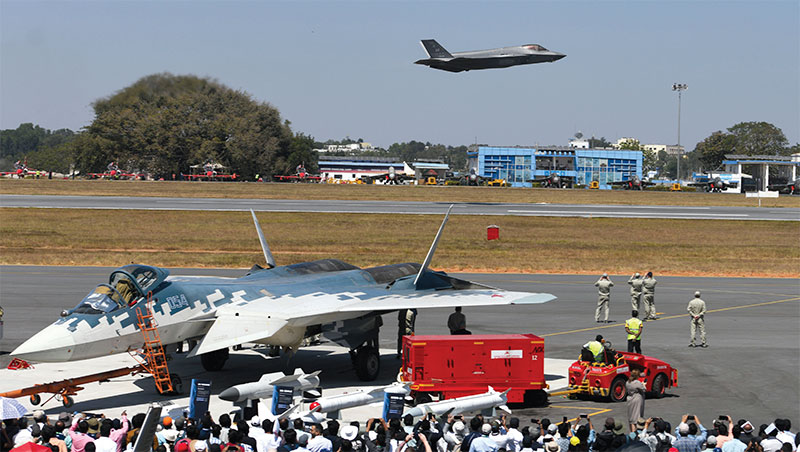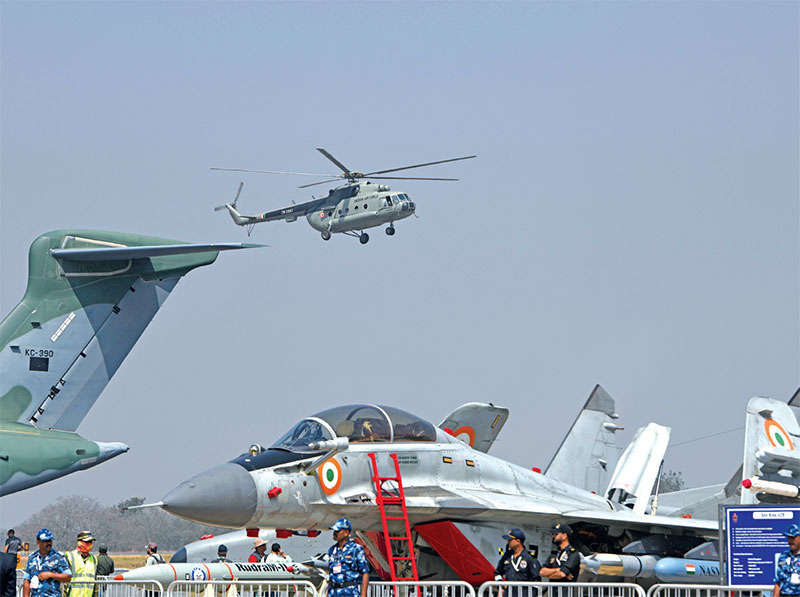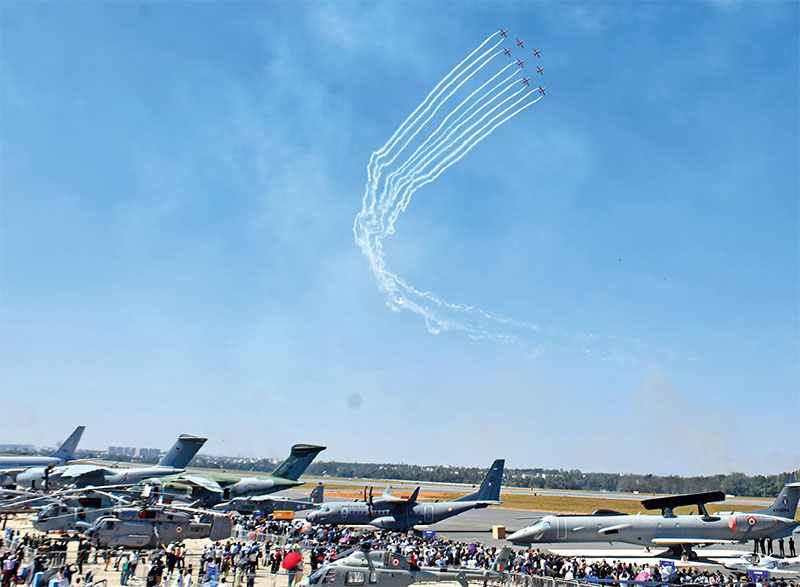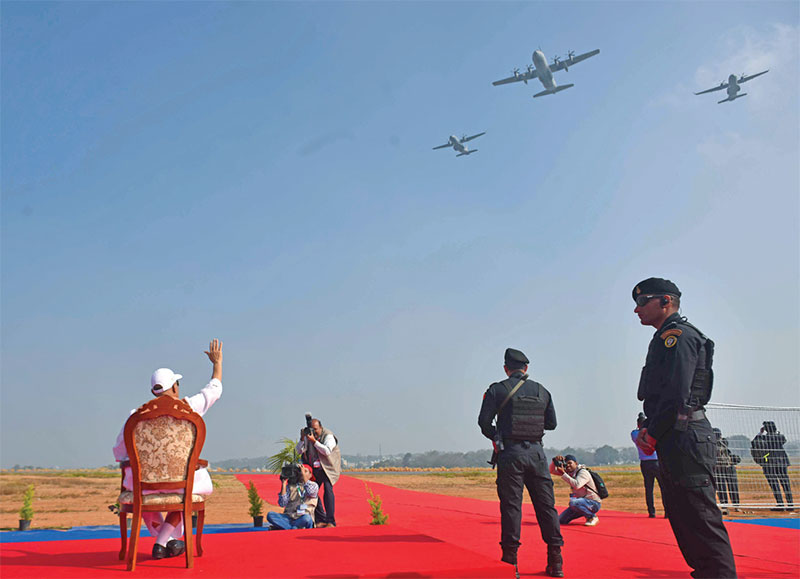A Big Spectacle
Ghazala Wahab
Yelahanka: The star of Aero India 2025, which was meant to showcase indigenous defence manufacturing to the world, was the chief of air staff, Air Chief Marshal A.P. Singh. He made news before, during and after the show. Even as the ministry of defence was platforming Indian defence industry with the intention of their getting plugged into the global supply chains of the original equipment manufacturers (which would add to India’s defence exports), the CAS reminded them in his own way that exports was merely the cherry on the cake. The primary objective of the defence industry was to meet the requirements of the Services.

To ensure that his message hit the spot, ACM A.P. Singh, staking his command, name and reputation, personally carried out the flypast in LCA-Mk1 A during the inauguration. This followed the joyride in the same aircraft the previous day, when took his army counterpart, General Upendra Dwivedi for a spin over the Bengaluru skies. While on the one hand, by repeatedly flying the Tejas, the chief was reposing his faith in the made in India fighter, not only for the IAF pilots, but also for possible export customers, on the other hand, he also took this opportunity to castigate Hindustan Aeronautics Ltd (HAL) for failing to meet the IAF’s requirements. Since then, the air chief has voiced his concerns about the continuously depleting numbers of IAF’s combat platforms. The failure of HAL to meet the delivery schedule of both Su-30MKI and LCA is compounded by the absence of progress on the Multi Role Fighter Aircraft (MRFA) programme, which seems to be stuck in a time loop.
This was reflected during the exhibition. Aero India 2025 was one of those rare airshows where there was hardly any flying. For reasons best known to them, the IAF didn’t fly its Rafale fighters. From the IAF’s combat arsenal, only LCA-Mk1 and Su-30MKI did the flying duty. And since the MRFA programme is sparking no confidence in the market, the only other fighters in the air were the Russian Su-57 and American F-35. Given that both the Russian and the American governments are offering their platforms to the IAF outside the MRFA competition, it is not difficult to imagine what the OEMs think about India’s Defence Acquisition Procedure (DAP).
As far as the helicopters were concerned, with all its ALH Dhruvs (total 330) grounded following a series of air accidents, HAL’s focus was on flying its Intermediate Jet Trainer. Which meant that of IAF’s two aerobatic teams, only the Surya Kiran, comprising Advanced Jet Trainer Hawk flew. The ALH-based Sarang did not.
What the show lacked in action in the sky, it made up in the crowd on the ground. Aero India 2025 was not only the biggest edition of the show until now, it was also the most crowded ever, both in terms of additional exhibition halls, which ate into the open spaces, as well as visitors. However, this growth came at the cost of shrinking foreign participation, which was reflective of their dwindling interest in the show. This is understandable. Since its launch in 2020, the DAP has yielded little in terms of competitive acquisitions. Most of the military wares for the Services are either government to government purchases or are being acquired through an Indian prime, who forms a partnership with an OEM in the garb of make in India. Under these circumstances, it makes no sense for global companies to spend money on a show which generates neither positive news, nor possible business.
Aero India now has two purposes. One, showcase equipment produced by Indian defence public sector companies (DPSUs), either indigenously or in collaboration with foreign OEMs to the militaries of the developing counties, say from Africa and South America, in the hope that they would buy them. For this purpose, young military officers were deployed as escort with each foreign visitor to market DRDO, HAL and BEL wares. One such duo was spotted with the AMCA (Advanced Medium Combat Aircraft) model, with the IAF escort summing up DRDO’s under-development fighter for his guest as, ‘It’s like F-35.’
Two, give a platform to Indian companies, mainly the start-ups and the MSMEs, to demonstrate their technological and manufacturing capacities to the OEMs so that they could either be selected as an offset partner or a supplier for their global markets. With this, the government hopes to realise its make in India dream, and through it, employment. No wonder, the most consistent news coming during the show was about JVs and partnerships among Indian MSMEs and big foreign companies.
But before India becomes the future defence manufacturing hub as dreamt by the prime minister, Aero India needs to become a professional show where a certain level of facilities can be taken for granted by those participating in it. The most basic requirement, to begin with, is a professional exhibition centre.
New Location
In his inauguration speech, defence minister Rajnath Singh had likened Aero India to the Mahakumbh (see box). He was right. In terms of chaos--induced mostly to accommodate the VIP visitors--, and breakdown of facilities, the two were quite similar.
But perhaps, at Aero India, the problem is more fundamental—the location. Air Force Station Yelahanka is simply not big or equipped enough to hold the show of this size. If Aero India has to be not only the biggest, but among the better shows in Asia, then it needs a professional venue. And Air Force Station Yelahanka is certainly not one. Here are four reasons why Aero India needs a better venue.
Nature of the Show: Aero India is a commercial exhibition in which aerospace industry from around the world comes to engage with the Indian industry. No doubt, until now this engagement was meant to serve the Indian armed forces alone, hence they were among the larger stakeholders at the show. However, now as India aspires to become an arms seller instead of being a mere buyer, it needs to reorient the show in the manner that attracts potential global customers. The old attitude that we have the biggest market so the world would come to us no matter what needs to change.
Security: With the airshow venue being a defence establishment, the IAF doubles down on its security during the show because it brings foreigners inside the station. The security drill starts right from the perimeter gates. And because this is India, where rules are meant to be adjusted according to the requirements of the powerful, or the technology available, the security drills also become shapeshifting creatures.
For instance, on February 10, when the defence minister, deputy chief minister of Karnataka and the entire ministry of defence had converged at Yelahanka, the vehicles were allowed inside the peripheral gates without any checking but were held up before the internal gates leading to the fairgrounds, causing a cascading hold-up for nearly half a kilometre forcing people to exit their cars and walk. The hold up was so bad that people were still trying to reach the inauguration venue well after the defence minister’s speech. Worse, the handheld scanners were not available at all access gates. So, while some frisked the visitors, others did not. Ditto for the x-ray machines.
On February 11, the situation changed. The vehicles were stopped at the perimeter gate itself. Some were not allowed to enter despite the access sticker on the vehicle because the duty policeman only knew how to wave the car away and not read the sticker. Once again there was a holdup at the gates with arguing drivers and screaming policemen turning the station periphery into a battleground.

Space: This also goes back to the venue. Since the IAF can spare only this much area for the airshow, to accommodate nearly 900 exhibitors, 80 per cent of them Indian, new halls were created in the existing space making the layout extremely cramped. This did not leave any space for building conference halls and briefing rooms. As a result, concurrent events, for instance, CEOs’ round table, were held in city hotels. This meant that the big bosses had to first struggle to get inside the show to mark their presence at the inauguration and thereafter struggle to reach Bengaluru to attend the conferences in the early afternoon, curtailing their first day at the show. Given that most CEOs attend the show only on the first or the first two days, this ate into their time at the show.
The space crunch also meant that most eating places, the VIP lounges and the food courts, were pitched well away from the main venue, forcing people to walk unnecessary distances in the heat. It was not just an inconvenience, but a waste of time.
Worse, the parking did not cater for all exhibitors, forget visitors. For instance, a company which booked a chalet and flew over 40 to 50 of their personnel, was allocated only two parking spots, even on payment. Yelahanka simply could not afford more space. And on the day when too many VVIPs descended on the show, even cars with parking stickers were shooed out of the venue because the visitors’ vehicles had to be accommodated.
Facilities: Toilets, toilets, toilets. And back to the venue. Unlike convention centres, say Bharat Mandapam in Delhi’s Pragati Maidan, air force station has no in-built facilities. And despite the present edition being the 15th air show (30 years, since it’s a biennial event), the air force station has not bothered to build any permanent facilities, because, well it is not an exhibition centre. So, everything is temporary and portable. Fair enough.
But the biggest mystery of the present show was that it had two halls dedicated entirely to made in India high technology, such as unmanned systems, yet it had been unable to figure out how to build portable toilets in which water runs in the taps and not form puddles on the floor. By noon of the first day of the show, most toilets had collapsed in the collective heap of incompetence. The remaining few had long queues outside. As one lady exhibitor, remarked while declining a glass of water, “No, no water for me. Otherwise, I will have to go hunting for a clean toilet.” Seriously, finding clean toilets at an international show should be the least of the worries of the exhibitors.

The Last Word
Finally, a word about mismanagement. Despite 30 years of organising defence exhibitions, the ministry of defence has still not got the hang of it. For example, treating all small exhibitors equally may be a fair practice, but it is not a reasonable approach. The media which pays to participate in the show and bring out daily specials needs to be distinguished from other exhibitors, because in a way, they are also service providers. They add to the experience of the show for the exhibitors. Hence, one, they should be allotted stands (for which they pay in any case) in a centralised area which makes it convenient for them to access the whole exhibition; and two, they should be facilitated in bringing in their show dailies every morning, instead of being thwarted, as happened this time.
Aero India, after all, is not just a meeting place for buyers and sellers. It is an experience for everyone who comes here. About time MoD understands that it’s the experience which creates a reputation. So, invest in a state-of-the-art convention/ exhibition centre near the airport, and shift the show there. The airstrip should not be a problem, because as the deputy chief minister D.K. Shivakumar said on February 10, in Bengaluru both the IAF and the civilian airport share it as a mark of civil-military fusion. Let Aero India show how civil military partnership can work.
Inauguration
In the absence of the Prime Minister Narendra Modi, who was co-chairing AI Action Summit in Paris, defence minister Rajnath Singh inaugurated the show. And like as his prime minister did in 2023, took the solitary spot on the tarmac after his opening speech to watch the air display.

Underscoring the importance of the show, he said in his speech that until the coming to power of Prime Minister Modi, the Indian defence industry was seen only as a national security requirement. However, the present government elevated the domestic defence industry to the status of a defence industrial complex, combining defence public sector undertakings (DPSUs) and the private sector. “Not only did our government recognise the importance of the defence sector, but it also regarded it as a top economic sector,” he said. “This is evident from the consistent increase in the defence budget year after year,” Singh added.
To further emphasise his point, Singh gave the example of corporatisation of the Ordnance Factories which he said has increased their efficiencies. Therefore, “India has taken a giant leap in innovation and technology development,” he said, adding that all these efforts have led the total turnover of the Indian defence industries to touch Rs 1.25 lakh crore.
Fresh from a holy dip at the Mahakumbh in Prayagraj, Singh likened Aero India to the religious congregation. He said that while the Mahakumbh at Prayagraj was about inner strength, the one at Yelahanka was about outer strength. While the former led to spiritual cleansing, the latter led to physical resilience, and so on. Carried away by the comparison, Singh spent the next few minutes describing the two events in the most florid of metaphors.
Concluding his address, Singh alluded to India’s non-aggressive past and the future peaceful rise. However, he qualified this with the assertion that peace can only be built on the foundation of strength. Hence, India needs to be militarily strong to enforce peace. And towards this end, his ministry has declared 2025 as the year of reform, for which both the DPSUs and the Services will work in close coordination.
Speaking before him, the deputy chief minister of Karnataka, D.K. Shivakumar, underscored the centrality of Bengaluru to India’s defence and aerospace sector, to which his government continues to contribute. According to him, over 60 per cent of all aerospace and defence manufacturing happens in Karnataka, employing over 1,50,000 lakh people. Shivakumar added the make in Karnataka twist to the make in India pitch.
Subscribe To Force
Fuel Fearless Journalism with Your Yearly Subscription
SUBSCRIBE NOW
We don’t tell you how to do your job…
But we put the environment in which you do your job in perspective, so that when you step out you do so with the complete picture.








